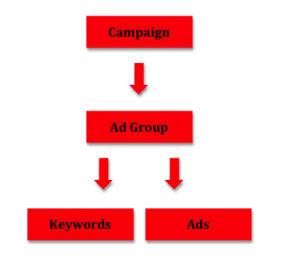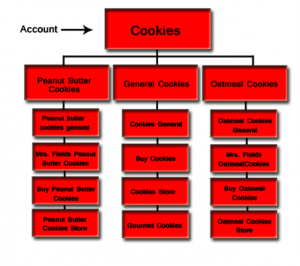Below is a break down of how PPC accounts are usually organized. They begin with campaigns, which are then broken down into ad groups. Each ad group has a specific, targeted set of keywords, and each ad group contains ad texts (preferably 2 or 3) that are relevant to the keywords in that ad group.

If you are looking at your PPC account and wondering “How can I make it better?” the first step is to analyze your account structure, and find areas of opportunity for making it more organized, and broken down into tight themes.
Below is an example of a well-organized account. You can see how the ad groups under each campaign are broken down so they are tightly themed. They each roll up to match the high-level campaign topic, and each campaign is relevant to the business for which the account was opened. Each ad group will contain relevant keywords and ad texts to best target customers throughout the buying cycle.

The best way to look at your account is from the bottom up. Start by asking yourself the following questions:
- Are the keywords in my ad groups tightly themed? Whether you prefer to look at keywords in the interface, in the desktop tool, or in excel, you need to be able to easily identify keywords that could be placed in a different ad group that would be more tightly themed. I prefer to use excel, and set a customized format to identify low quality score terms. We will discuss ways to improve your quality score later this week, but for now you just need to know that a low quality score usually means there is an opportunity to restructure your keywords.
- Are the ad texts in my ad groups relevant to the keywords within the group? Good ad text goes hand in hand with having tightly themed keywords in your ad group. If you have keywords like ‘buy cookies’, ‘cookie store’ and ‘peanut butter cookies’ all in the same ad group your ad text isn’t going to be very targeted to the specific keywords which can hurt your overall traffic and revenue.
- Do each of my campaigns contain ad groups that are relevant to the high-level campaign topic? Just like you want your keywords and ad texts to be relevant to the overall ad group theme, you want your ad groups to relate to the campaign they are in. A good rule of thumb is to incorporate your keyword into the corresponding ad group name. Each ad group name should also contain the keyword that is your campaign name. Refer back to the image above. See how the Peanut Butter Cookies campaign has ad groups that each contain the term “peanut butter cookies”? Though there are other qualifiers in the ad group names, they all pertain to that one, often times general, keyword that is the campaign name.
When grouping keywords try to aim for no more than 10 terms in each search targeted ad group, and no more than 5 or 6 keywords in each content targeted ad group. Sometimes your business requires that you have more than this, but as a general rule of thumb, if your keywords are limited to these caps, you can be sure the ad group is tightly themed, and it will be much easier to write relevant ads.
Once you’ve verified that your keywords are well organized, you can look at your ad texts to make sure you are showing your customers the best message possible. Think about where they are in the buying cycle when they will see your ad. It’s also a good idea to do some competitive analysis to identify your strengths and weaknesses. This will also help you be aware of any promotions that your competitors may be running, so you can be sure that your ad texts contain offers or benefits that can compete.
There are multiple reasons an account should be structured well. First and foremost you can be sure that you are reaching your audience effectively, and showing them relevant messages for their search queries. It is also easier to manage your account, because you can easily identify the areas that need improvement without having to fish through an endless keyword list or multiple ad texts. Finally, Google will reward you by giving you higher quality scores on all levels, which will in turn lower your bids and hopefully save you some money.
When restructuring your account, especially one that contains historical data, there are a few important things to remember:
- Maintain good quality scores. Say you want to move Keyword A from Ad Group 1 to Ad Group 2. If Keyword A has a good quality score, in order to keep it you will need to also move the best performing ad from Ad Group 1 to Ad Group 2.
- Make your ad group names descriptive. You won’t be penalized for creating good names that are descriptive of the ad group theme. You can update current ad group names without losing historical data, so change them if necessary.
- Don’t pause old ads all at once. If your keywords are tightly themed, but you still have low quality scores on your terms, try writing new ads that are more targeted. Just be sure that you allow the new ads to generate some data before you pause the old ones. This will give your ad a chance to build up some click-through rate data, which will directly impact your ad group’s quality score and bids.
Just remember that relevancy is most important when organizing your pay-per-click campaigns. The more relevant your ad text is to your set of keywords the better the click-through rate is. And that lends itself to many other factors including increasing traffic, revenue, quality score, etc. Plus, from an advertiser standpoint it’s much easier to manage an account when it’s properly organized than when things are all jumbled together. An organized account is the most important thing when managing a PPC account. It will help of hurt your quality score and dictate how you perform in search engine rankings.




